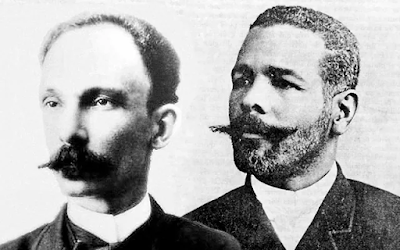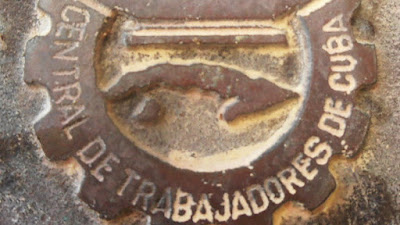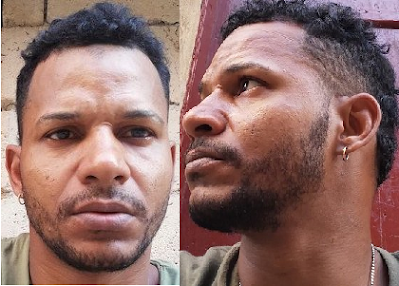Before the arrival of the totalitarian darkness
 |
| Independence Day in Havana, Cuba on May 20, 1902 |
One hundred and twenty two years ago today at noon the flag of the United States was brought down and the Cuban flag raised over Havana as Cuba became an independent republic. However, when looking at Cuba one should look back over the first 467 years [1492 - 1959] and where it is situated today to gain greater understanding of the unfolding tragedy.
Cuba is just 90 miles south of the United States with a population of approximately 11 million people. It is 780 miles long and has a land area of 40,369 square miles and is the largest island in the Caribbean and 17th-largest island in the world by land area.
 |
| Cuba seen from space. |
Columbus’s second stop in the New World was on October 28, 1492 when he landed in Cuba. (The first place he landed on October 12 was the Bahamas). Cuba was a Spanish colony from Columbus’s landing in 1492 until 1898 when Spain lost Cuba in the Spanish-American War.
 |
| President Tomas Estrada de Palma |
Cubans engaged in two protracted wars of independence. The first was the 10 Years War that took place between 1868 and 1878 and the second took place between 1895 and 1898 ending with U.S. intervention and a 4-year occupation that ended on May 20, 1902. Cuba's first president was a Cuban exile named Tomas Estrada de Palma.
 |
| Future first Cuban president Tomas Estrada de Palma travels to Havana |
There are many important figures and entities that emerge in the 19th century but for
the sake of brevity will mention Father Felix Varela, Jose Marti,
Antonio Maceo, Maximo Gomez and the Bacardi family.
Father Varela was a catholic priest who is said to “have taught the Cubans how to think” and entertained ideas of independence that led to his exile to the United States.
Antonio Maceo and Maximo Gomez were Cuban generals that played important roles in both wars of independence. Antonio Maceo was of a mixed racial background: part Spanish and part African.
Maximo Gomez, was an experienced military man of Dominican origin who oversaw the overall military campaign in the second war of independence and of the three previously mentioned was the only one who survived the war to see the arrival of the Republic.
 |
| José Martí and Antonio Maceo |
Jose Marti was a journalist, poet and revolutionary who organized and advocated for the 1895 war of independence and spent most of his adult life exiled in the United States in New York City.
The Bacardi family, began their world famous Rum business in Santiago de Cuba. Don Facundo Bacardí Massó and Don Emilio Bacardi founded Bacardi Limited on February 4, 1862.
Emilio Bacardi Lay, son of one of the two founders of Bacardi, Don Emilio Bacardi, "was a field officer for Gen. Antonio Maceo in 1895 during the invasion of Cuba by independence forces, and reached the rank of colonel by the age of 22," according to his obituary in The New York Times on October 16, 1972 when he died at the age of 95 in exile in Miami.
 |
| Emilio Bacardi Lay |
The family would also play an important role in
civic life in Cuba, especially Santiago over the 20th century, and were
constant opponents of dictatorship, political corruption and remained
ardent Cuban nationalists over several generations.
Forced into exile by
the Castro regime the Bacardi family has maintained the traditions of
the Cuban Republic celebrating independence day, carrying on the family business and continuing the fight for a free Cuba.
The beginning of the Cuban republic on May 20, 1902 had an asterisk –
The Platt Amendment: which allowed the United States to intervene in
Cuban affairs if U.S. interests were threatened. This Amendment was
gotten rid of in 1933 but left a bad taste in the mouth of Cuban
nationalists.
Between 1902 and 1952 Cuba progressed socially and economically but
faced challenges on the political front. For example in the late 1920s
Gerardo Machado, the democratically elected president did not want to
leave power becoming a dictator. He was driven from office and into exile in 1933 by a general strike.
This was followed by a revolution led by university students and enlisted men in what became known as the sergeants revolt.
During this period labor unions made great strides for worker's rights in Cuba, especially after the ousting of President Gerardo Machado in 1933.
Ramon Grau San Martin's provisional government marked a before and after in Cuban history. Between October and December of 1933, it issued a first package of popular and nationalist measures that strengthened labor rights in Cuba.
- Created the Ministry of Labor, since there was no body specifically in charge of labor matters.
- Established employer liability for accidents; he suspended the evictions of tenants and canceled 50% of the taxes and contributions not paid in due time.
- Established the eight-hour work day and the right to unionize. He promulgated the Labor Nationalization Law that established the obligation that 50% of the workers and employees had to be native Cubans.
Labor legislation passed in 1938 guaranteed Cuban workers' additional rights:
- A minimum wage;
- Pensions that assumed a constitutional character;
- Creation of the Central of Workers of Cuba Central de Trabajadores de Cuba (CTC in Spanish)
In 1940 all the political tendencies in Cuba met to draft what became known as the 1940 Constitution and a presidential election was held and Fulgencio Batista elected. He served out his term as president from 1940 to 1944. Due to a clause in the new Constitution he was unable to run for re-election. Cuba's 1940 Constitution further enshrined workers’ rights into law with 26 articles which included:
A maximum work day of no more than 8 hours and a maximum working week of 44 hours equivalent to 48 in wages (Article 66); The right to paid vacation of one month for each 11 months of work in each calendar year (Article 67); The right of unionization (Article 69); The right to strike (Article 71); The system of collective labor contracts (Article 72); a non-discriminatory practice in the distribution of opportunities to work ( Article 74).
Strong trade unions and labor legislation in the Cuban Republic were a factor in rising living standards, and improved healthcare outcomes.
In the election of 1944 the opposition candidate,
Ramon Grau San Martin, won and served a term as president from
1944-1948 and in the election of 1948, Batista’s political party again
lost at the general elections and Carlos Prios Socarras was elected president.
Cuba's republic during this democratic period played an important role in the drafting of the Universal Declaration of Human Rights of the United Nations and the establishment of the UN Human Rights Commission.
This democratic renaissance was brought to an end within days of the
1952 presidential elections, when on March 10th Fulgencio Batista
organized a coup against the last democratically elected president.
A little over a year later on July 26, 1953, Fidel Castro organized an
armed assault on the Moncada Military barracks that was a military
disaster but a public relations success. Although most of the men
involved with Fidel Castro in the assault were killed, Fidel Castro
became a national figure at his trial for organizing the attack. At the trial he
portrayed himself as a democrat that wanted to restore the previous
democratic order and attacked the Batista dictatorship for its
usurpation of the democratic order.
How the totalitarian darkness arrived in Cuba
Upon Batista’s departure from Cuba on January 1, 1959 Fidel Castro began his triumphal trek across Cuba to Havana where he began to consolidate power while continuing publicly to claim that he was a democrat but privately began to infiltrate his movement with communists, alienating many who had fought with him.
On January 22, 1959 the CTC was replaced by the CTC-Revolucionaria.
In the X Congress, held in November 1959, the Secretary General, David
Salvador Manso,"said that the workers had not gone to the event to raise
economic demands but to support the revolution." And in the XI
Congress, November 1961, the delegates renounced almost all the
achievements of the labor movement, including "the nine days of leave
for sickness, the supplementary Christmas bonus, the weekly shift of 44 x
48 hours, the right to strike and an increase of 9.09%, among many
others. Workers were required to do "voluntary work" that was actually mandatory.
Castro began to approach the mass media threatening them with violence if they reported anything critical. As the months passed all independent media were taken over. Mass televised executions imposed fear in the populace.
Ramiro Valdez oversaw the installation of the totalitarian communist apparatus in Cuba beginning in 1959. He is now probably doing the same thing in Venezuela. It was on his watch that the East German Stasi, and KGB created and trained Cuban State Security.
This is how the darkness of totalitarianism took over Cuba and 64 years
later remains entrenched there. Cuba gained its independence on May 20,
1902 after centuries of Spanish colonial rule and four years of U.S.
occupation following the Spanish American war.
Half of Cuba's post colonial history, thus far, has been under the boot of communist caudillos whose father, ironically, fought for the Spanish crown in the war of independence.
What would José Martí say?
 |
| José Julián Martí Pérez: January 28, 1853 - May 19, 1895 |
José Martí was killed in battle against Spanish troops at the Battle of Dos Ríos, near the confluence of the rivers Contramaestre and Cauto, on May 19, 1895. He is buried in the Santa Efigenia Cemetery in Santiago de Cuba. Cubans the world over honor his memory and Cuban independence follows a day later. Seven years and one day after Martí's death Cuba formally obtained its independence on May 20, 1902.
Cubans across the ideological divide claim José Martí as their own. The claims of the dictatorship led by the Castro brothers that Martí is the intellectual author of their political project is ironic considering that the life and writings of this Cuban patriot is the antithesis of the Castro regime.
José Martí believed that "Peace demands of Nature the recognition of human rights." A 64 year old dictatorship that rejects fundamental human rights is the antithesis of what the Cuban independence leader fought and died for.
Furthermore, José Martí proclaimed the idea that: "One just principle from the depths of a cave is more powerful than an army."
A principle shared not only by dissidents in Cuba today but also echoed by Vaclav Havel, one of the dissidents who had an important role in ending Communism in Eastern Europe in 1989 said: "I really do inhabit a system in which words are capable of shaking the entire structure of government, where words can prove mightier than ten military divisions."
On this Cuban Independence Day we observe that Cubans have lived without democracy for 72 years, and rededicate ourselves to the struggle for a free Cuba.
 |
| May 20, 1902 the Cuban flag is raised and the Republic born |







